What a Diamond Cert Won’t Tell You About Its Appearance
One of the biggest mistakes you can make when buying an engagement ring is to shop based on a diamond certificate. For people with a larger budget to purchase top clarity grades like IF, VVS1 or VVS2, you probably don’t have to worry about clarity issues.
However, if you intend to shop for value and want to go lower in clarity ratings to save money, you would be taking a huge risk with “blind shopping” when you only depend on a grading report.
A diamond cert will only provide you with information about the diamond’s gemological properties but it doesn’t tell you everything about its appearance!
How would you be able to select eyeclean diamonds within the VS2-SI1-SI2 clarity range when you don’t know how the inclusions look like or how they would impact the diamond’s overall appearance?
In this write up, I’m going to show you why buying a diamond based on a certificate is a bad idea and how you can avoid clarity pitfalls simply by shopping smart. Let’s dive in…
Never Buy Blind! You Will Only Be Gambling With Luck.
Very often, grading reports for diamonds with carat weights less than 1.00ct do not show a reference plot for its inclusions (e.g. GIA Dossier report). Instead, the clarity features of the diamond would simply be indicated under the “comments section” with a couple of words.
That’s a big problem because it is impossible to judge a diamond’s appearance accurately based on a few descriptive words.
As an illustration, let me show you 2 GIA grading reports for diamonds with the same color, clarity and cut grades. Feel free to download the reports and verify them yourself by clicking the links below.
0.73 Carat G-SI2 Excellent Cut Round Diamond – GIA Report Number #2141474872
0.73 Carat G-SI2 Excellent Cut Round Diamond – GIA Report Number #2135963357
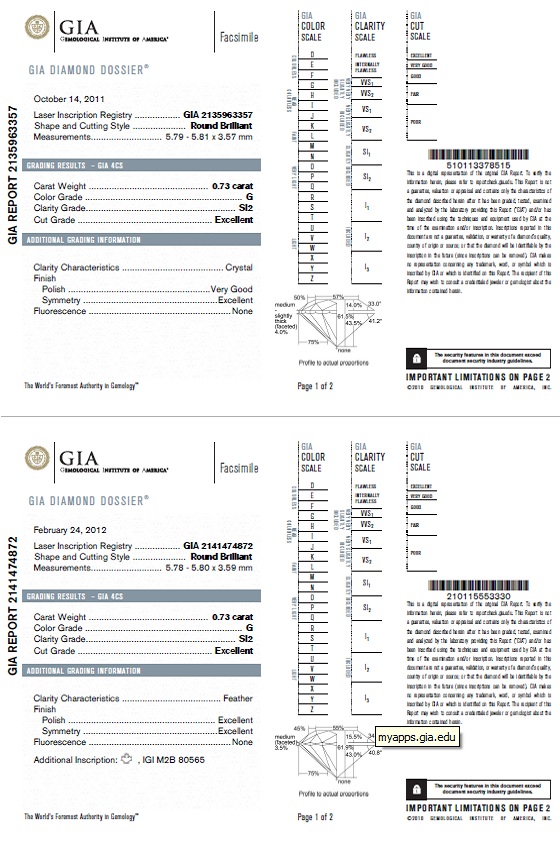
Based on the GIA certificates alone, these 2 diamonds appear identical to each other and they are both SI2 clarity diamonds. The first diamond has a “Crystal” listed as its clarity characteristics while the second diamond has a “Feather” inclusion.
On paper, you probably can’t tell anything out of the ordinary between these 2 diamonds. However, this happens to be a huge pitfall for unwary consumers who don’t understand how things work.
If you bought the 2nd diamond simply by basing your decisions on the grading reports, you would be in for a RUDE SHOCK.
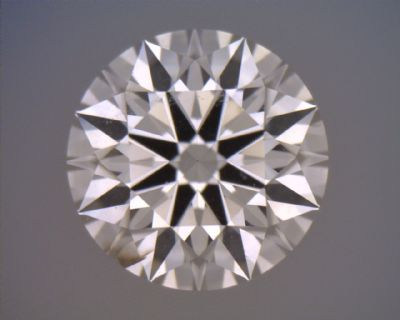
Diamond with GIA #2141474872
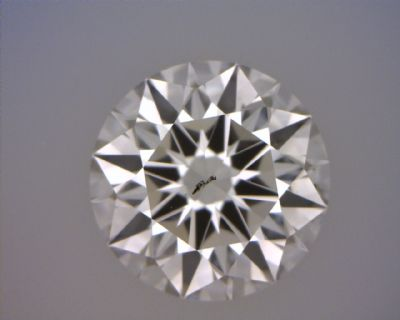
Diamond with GIA #2135963357
Having seen photographs of these two diamonds, which one would you choose now? Would you choose the first diamond with the eyeclean crystal inclusion or the second one with the dark, black feather under its table facet?
I guess the answer will be pretty obvious which diamond is hands-down the better choice!
These Aren’t Isolated Cases. I Can Show You Even More Examples…
Even if you are looking at a full grading report with an inclusion plot, there are details that aren’t revealed without closer inspections. Sometimes, harmless looking plots can actually turn out to have unsightly inclusions!

Crystals can exist in different colors depending on the type of embedded mineral. In this particular example, the crystal takes on an awful opaque appearance.
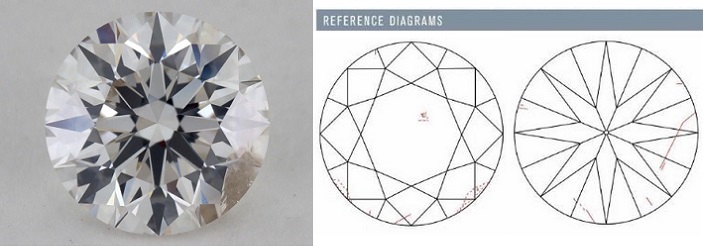
In this example, the crystal inclusions at the center of the diamond aren’t visible to the naked eye as they are transparent. However, the real concern is the cloud located at the 5 o’clock position.
As you can see, the lab report is like a 2D map. It is only able to show you the type and location of inclusions in a diamond but there are no indications about the intensity of cloud particles or the coloration an inclusion has.
A Grading Report by Itself Isn’t Sufficient!
Did you know that some online stores (e.g. Bluenile.com) WILL NOT provide any further details (like photographs or videos) beyond a grading certificate for some of their listings?
Even if you are shopping in a physical brick and mortar store, did you know that the SAME PROBLEM applies? You see, most jewelers don’t hold much inventory in their store because of the high costs involved in stocking them.
When most people don’t find what they are looking for, jewelers usually offer to “call-in” a diamond from another location on your behalf and require a non-refundable deposit or full payment. This is a trap that many first time shoppers fall into when they hand over their money. What’s happening here is that the jeweler is shopping blindly on your behalf while you shoulder all the risk!
Seriously, there’s no way you can make rational buying decisions with limited information. If reading this article doesn’t change your mind about buying blind, my advice is to stick with a minimum clarity of VS1 or better.
Bottomline – How to Shop For a Diamond the Right Way
Whether you are buying your engagement ring in a physical brick and mortar store or online, you MUST ALWAYS request a magnified photograph/video of the diamond. This will not only help you determine whether the stone is eyeclean, it will also help reveal other aspects of cut quality.
The bottom line is, if the jeweler you are dealing with can’t even provide data like these without requiring payment from you, there’s absolutely no reason for you to do any business with them.
There are plenty of great vendors that go above and beyond in providing tangible data to help you make an educated purchase decision.
James Allen’s 360° videos enable you to scrutinize diamonds in a neutral environment.
Related Articles
Leave A Comment


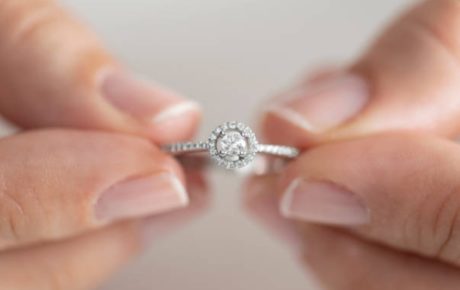

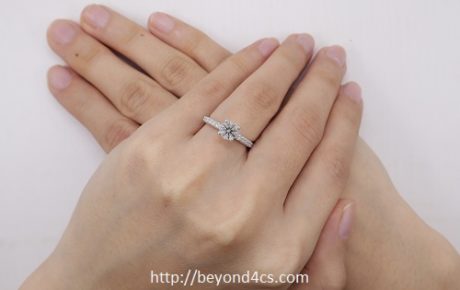
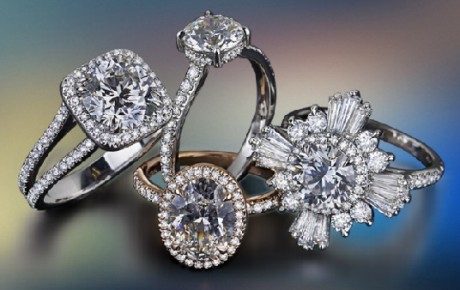









19 Comments
very instructive. the lesson is: inspect it yourself and keep a lookout for diverse impurities.
thank you
Hello! I’m trying to purchase a diamond and find it to be extremely confusing! My budget is no more than 8000 for the diamond. I going to have a custom setting made using other diamonds from my original engagement ring. I want a good diamond that I can pass down to my daughter.
What do you think about this one? It’s over my budget but I haven’t found another that seemed to be of good quality.
Thank you for your help!
This diamond (https://www.jamesallen.com/loose-diamonds/round-cut/1.05-carat-g-color-vvs1-clarity-ideal-cut-sku-1032748) is a well cut option.
Looking for a 1.27-1.4, F-H, X3, no-faint fluorescence, table 54.4-57.5%, depth 56.9-63.9%, for < $7400. Do you have any recommendations? I found a bunch on JamesAllen but wasn't sure if the characteristics were going to be eye clean (gemologist thought this one might be despite the wisps: https://www.jamesallen.com/loose-diamonds/round-cut/1.33-carat-h-color-si2-clarity-excellent-cut-sku-937066 )
The diamond’s eyeclean but there’s 2 issues I have with it:
1) The stone might be slightly hazy due to the immense amount of twinning wisps in it.
2) The crown angles are too high.
Hello. I am looking for stud earrings for an anniversary present and I have landed on these two stones after a pretty exhaustive search. I will see them in person tomorrow at a wholesaler:
GIA #15379074 and GIA #5213644718
What do you think? And what would be a fair price, unmounted?
Thank you for your time!
David
If you are buying an engagement ring in person, request to see the diamond under a loupe or a microscope. You should get the jeweler to show you where the diamond’s inclusions are and check to see if they are eye-visible without any magnification aids.
Also, you should also request tangible data about the cut performance of the diamond to help you get an unbiased idea of the cut quality.
If you have further questions, you probably want to email me directly.
Hi Paul, I have been looking on the James Allen site as trying to source a 3ct Pear shape d-f around $45k -$50k. For value I am looking at VS2/SI1 but with excellent symmetry and polish. Where I am struggling with knowledge are the inclusions and the spread although I did read your last article which was very useful.
Any help would be appreciated.
Hi Paul,
I found your instructions very helpful and gives me the reassurance to buy from online retailers like James Allen. May i ask you to comment on the clarity of this stone that I am now still considering.
Are there any cloudy inclusions or any red flags that you might detect which an untrained eye such as mine would have missed?
https://www.jamesallen.com/loose-diamonds/emerald-cut/2.33-carat-h-color-vvs1-clarity-sku-896845
Inclusions will never be an issue in a VVS1 diamond graded by GIA.
Blue Nile has taken your hint and have started to update their site to include 360° views.
Thank you for the very helpful article!
Yep. They did. : )
I’ve actually updated my review of them and they actually are a much much better company to work with.
Hello.
I purchased a very small pair of diamond stud earrings in 14k yellow gold and I did NOT know they came from China…very stupid of me but it is a waste of apx $150.
My concern is simple: how or where can I go to find out if these are the very high quality man made diamonds that China has found a way to pass off as REAL diamonds?
Thank you for your time and help.
Susan
Forgive me…they are only .25 ctw set in 5 prong 14k yellow gold.
*my jewelry box fell and the studs I have had for over 30 yrs…I can only find one and I have ripped my room apart looking for the other one
I have not been able to find the other so I punched this from China.
If you bought it for $150, you really shouldn’t expect it to be of high quality jewelry. To give you a benchmark, a typical yellow gold ear ring setting without any center stone would cost more than $150. The diamonds could be real but the truth is, small sized low quality diamonds are dirt cheap. Without any details, I cannot tell you anything constructive and the figures don’t add up. Even if you did lost the “diamond” stud, it’s not a big monetary loss and I doubt its even a diamond in the first place.
Hi Paul, Thank you sooooo much! I found your article very very helpful. I am currently in the market for an engagement ring for my beautiful partner and I am inexperienced when it comes to diamonds as this is the first time I have bought one.
I have been to diamonds international and found a ring I like which is a 18ct white gold cushion halo. I have to have the ring made so i can get the appropriate band size etc… the jeweller has found a diamond that she suggests should be a beautiful diamond, but it is not in stock yet. she has given me a GIA certificate number which I have looked up, however I don’t know if I should be worried about things like the clarity characteristics such as cloud, crystal and feather.
based on this report;
https://www.gia.edu/report-check?reportno=2246070284
subject to me actually physically sighting the diamond when it arrves in store, would you suggest that this is a good diamond, and if not, what areas should I be most wary of in a cushion diamond?
Thank you again, you made a lot of the commonly used diamond language a lot more newbie friendly.
There’s nothing I can tell you about the cut quality or performance of the diamond. Shopping for a cushion cut diamond based off a grading report is simply asking for trouble and risky. Most cushion cuts are mediocre in terms of cut and the grading report alone DOES NOT offer anything useful.
Read this: https://beyond4cs.com/where-to-buy-fancy-cuts/
From what I understand, it’s already too late. All you need to do is pray that you get extremely lucky (odds are stacked against your favor) to get a decent stone. Clarity wise, the inclusions shouldn’t be an issue. That shouldn’t be your concern. Cut quality is.
Thank you paul! I have not yet purchased the diamond. they were getting it brought in store for me to look at. it came in store today and I asked the cut quality and she mentioned it was excellent. looks like I should just have to cross my fingers and legs and hope it is as nice as it sounds!
Being in the industry long enough, I can tell you that jewelers and everyone else will tell you what you want to hear to make money off the deal. If you went up to a restaurant and asked them whether their soup of the day is tasty, I would be surprised they would be blatantly honest about it if it wasn’t.
What I am trying to say is, if you are asking these questions, you better be researching and know exactly what to look out for when it comes to light performance in cushion cuts.